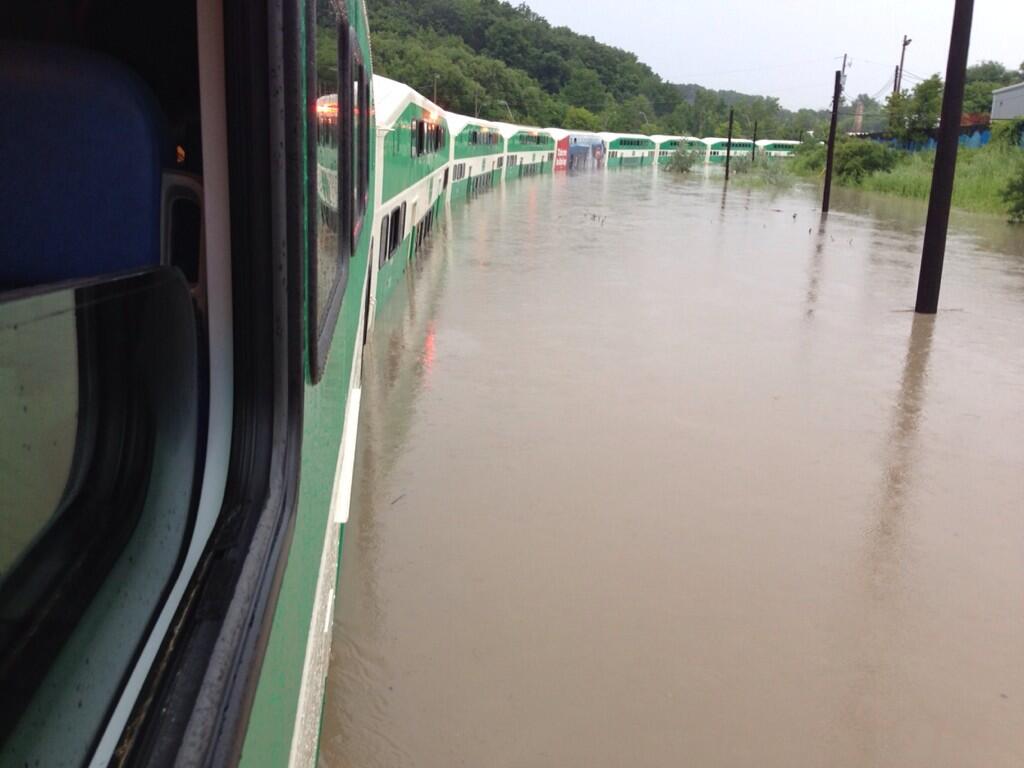UPDATE (Jul. 9, 2013 – 5:02 p.m.) : A spokesperson from Toronto’s Office of Emergency Management told Global News that the city made an executive decision to tweet from the official City of Toronto Twitter (@TorontoComms) so that it would reach more social media users.

—
TORONTO – During the height of Monday’s record-setting storm, Toronto residents took to social media to scour the web for updates and information about everything from power outages to transit troubles.
But in the midst of the chaos, there were a few noticeable absences on social media.
Shortly after 5:30 p.m.ET, a GO train, on its way to Richmond Hill from Union Station, got stuck in high waters near the Bayview extension. As flood waters began filling the bottom level of the double-decker train, commuters began tweeting images of the flooded train and asking for information regarding their rescue.
Meanwhile, GO Transit’s official Twitter page – a normally active account that had been responding to regular customer inquires up until 5:07 p.m. – was silent.
The account did not tweet any information regarding the flooded GO Train, or weather delays on other routes, until 8:19 p.m.
Emergency crews began rescuing stranded passengers on the flooded GO Train around 9:30 p.m.
Go Transit’s Twitter account description contains the line “Not monitored 24/7.”
Global News contacted media relations at GO Transit on Monday evening and none of the three information phone numbers at GO Transit were answered.
Global News was able to contact a representative from GO Transit on a cellphone at 7:18 p.m. who said he would get back in touch with Global News with more information. He called Global News back at 8:18, as GO Transit also started tweeting updates. Global News was told that GO Transit was trying to open windows on the train and that it would try to move the train to a platform.
- Ontario First Nation declares state of emergency amid skyrocketing benzene levels
- Singh mulls TikTok return as U.S. nears potential ban over security fears
- More financial institutes are offering crypto-services, survey shows
- Possible TikTok ban in U.S. looms after Biden signs bill, setting up legal fight
Global News contacted GO Transit again on Tuesday to obtain a statement regarding the lack of communication about the stranded train on social media and what protocols GO Transit has in place for social media response in emergency situations.
GO Transit did not respond to requests for comment at time of publishing.
The lack of tweets caused GO Transit passengers and those following the storm on social media to criticize the organization.
Tweets to the GO Transit Twitter account ranged from sarcastic – one user tweeting, “Hey @GOTransit, I’m stuck on your 5:30 Richmond Hill train and oh yeah, it’s flooding,” – to angry – another user tweeting, “@GOtransit needs a new social media person yesterday. No communication during times like these just makes it worse.”
After 8:19 p.m., the account actively tweeted updates until 11:15 p.m. and began tweeting Tuesday morning just before 6 a.m. for the morning rush.
Similarly, Toronto’s Office of Emergency Management came under fire for only tweeting once during the storm.
The account (@TorontoOEM) tweeted, “For information on current status of Toronto power outages follow @TorontoHydro,” just after 11:00 p.m. Monday – hours since initial reports of power outages and flooding began.
Though the Twitter account notes that it is not monitored for incoming messages – explaining the lack of direct communication with other users – users were clearly frustrated with the lack of communication from the office.
“Whoa! Way to tweet up a storm (#stormTO) there, @TorontoOEM,” said one user Vicki Ziegler (@vziegler).
Other responses to the tweet included, “@TorontoOEM #facepalm #useless” and “pathetic.”
The Office of Emergency Management’s mandate reads, “Helping Toronto and its residents prepare for and deal with major emergencies and disasters is the primary purpose of the Office of Emergency Management (OEM), the City of Toronto’s coordinating agency for emergency and disaster activities.”
After Hurricane Sandy related storms caused damages in Toronto in October, Toronto City Councilor Kristyn Wong-Tam submitted a recommendation that the Director of the Office of Emergency Management review the protocol and communication strategy during emergencies.
Global News contacted the Office of Emergency management to obtain a statement, but did not receive a response by time of publishing.
On Tuesday, Transportation Minister Glen Murray posted this video on YouTube:
Correction: An earlier version of this story said that Global News contacted media relations at GO Transit on Monday at 7:30 p.m.ET and learned that their public relations representatives had gone home for the evening.
It has been changed to indicate that none of the three information phone numbers at GO Transit were answered, and that Global News was able to contact a representative from GO Transit on a cellphone at 7:18 p.m. who said he would get back in touch with Global News with more information. He called Global News back at 8:18, as GO Transit also started tweeting updates. Global News was told that GO Transit was trying to open windows on the train and that it would try to move the train to a platform.




Comments